|
Monday, September 10, 2007
Progress Notes
The Tuscumbia Bridge across the Osage River (photo1 using close up lens) has been in the news lately regarding its structural integrity: (click here). State Inspectors were here last week and did find some problems for which a temporary twelve thousand pound weight limit restriction has been established as well as a prohibition of truck traffic across the bridge (photo 2). As you can see by the photo of the bridge which I took the other day from the back yard of Monty and Brenda Laffoon's house, the bridge looks worn out. Compare this photo to one taken from the same approximate location when the bridge was being painted regularly (photo 3). The bridge news inspired me to feature the bridge crossing at Tuscumbia in this week's Progress Notes. The history of crossing the Osage River at Tuscumbia was summarized some fifteen years ago by my Uncle David Bear:
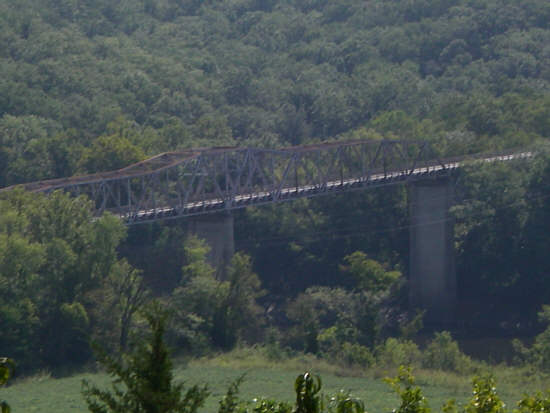 01 Osage River Bridge 9 Sep 07
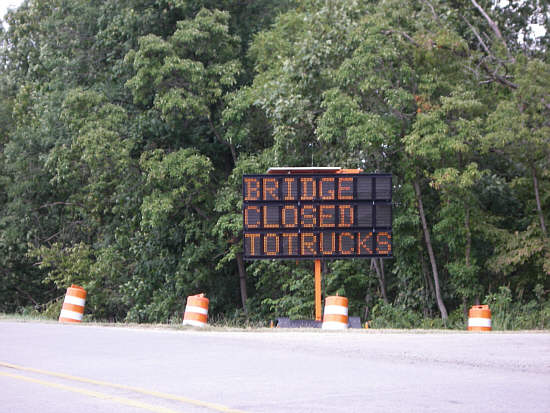 02 bridge sign
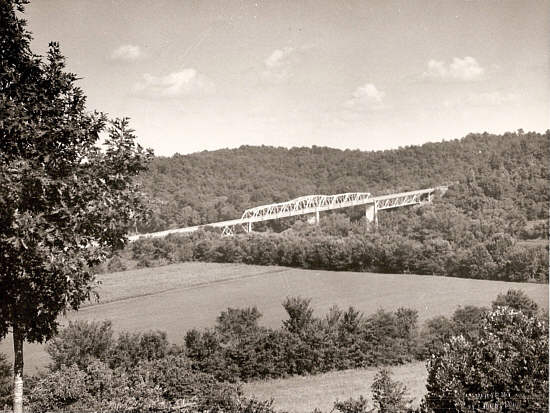 03 new bridge at Tuscumbia "Rivers can be obstacles to land transportation. The early settlers had to deal with crossing streams to reach their destinations. The settlers on the south side of the Osage River from Tuscumbia needed to get to town occasionally to buy and to sell. In the summer, there were usually a few shallow places where the river could be forded but for year round transportation, a ferry was operated. The landing was near the present boat ramp in town (photo 4). To do a better job of helping the public, a private corporation built a bridge in 1905. This was a suspension bridge with just one lane (photo 5). In approaching the bridge, one had to watch carefully to see if someone was coming across from the other side. Once on the bridge, it was difficult to back up a team of horses. The gate keeper also helped keep watch. A toll charge was assessed for crossing. My memory is that it cost fifteen cents for a team to cross. Later, the charge was twenty-five cents for automobiles. I remember the bridge very well. It was scary for me. It would swing in the wind and the wood planks made quite a noise. It was scary to walk across because of its height from the water and the swaying of it. My brother-in-law, Bob Stillwell, while on summer vacation from school, helped paint the bridge one summer. All the money in Miller County couldn't have enticed me to do that job! Arthur Ewing was the toll keeper for many years. He lived in a shack at the south end of the bridge. If he didn't want to stay up all night, he locked the gate to keep people off the bridge. He collected and took the proceeds to the bank weekly and always carried them in a gallon syrup bucket to camouflage his activity. But everyone knew what he was doing. The swinging bridge was of the wire suspension type and was dedicated on 5 August 1905. It was 620 feet long and 14 feet wide, built at a cost of ten thousand dollars."
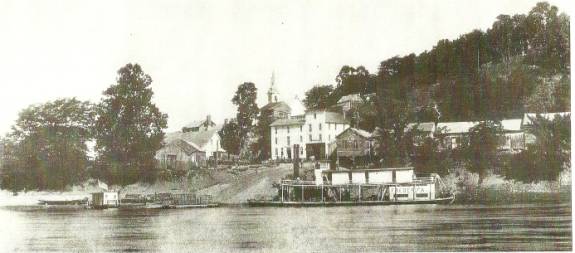 04 ferry landing If you will magnify the photo I notated above (photo 5) and read the sign at the top of the entrance you will observe that it says: "No traffic faster than a walk on this bridge" which obviously indicates that the traffic was by horse and not automobile. One of the photos of the old suspension bridge (apparently at the time of a flood) is from an old postcard which Mrs. Robert M. Marshall had sent to Dr. Marshall Humphreys' great grandmother, Mrs. Uriah Humphreys (photo 6). I wondered how the Bob Marshalls' (he was a former steamboat captain and partner in the Anchor Milling Company) knew the Humphreys family up in Galt Missouri. Marshall Humphreys III told me that both couples regularly went to south Texas for the winter and may have met down there, although he wasn't sure. At any rate, I found that an interesting coincidence.
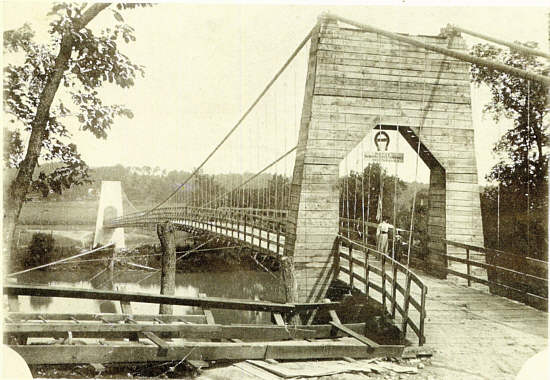 05 suspension bridge at Tuscumbia 1905-1934
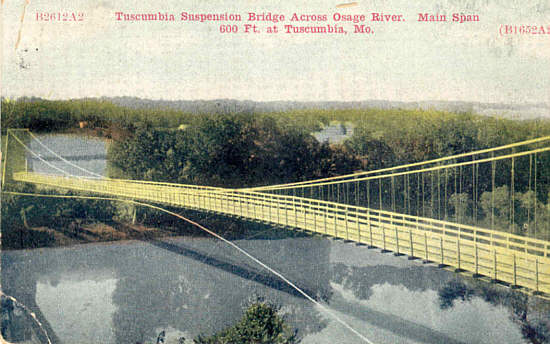 06 suspension bridge sent to Uriah Humphrey by Mrs. Marshall The bridge (photo 7 taken when bridge was new) was a steel structure which was dedicated on October 23, 1933 to a crowd of five thousand people by Governor Guy Parks after a large parade was held. Ninety three year old Squire John Ferguson of Iberia (photo 8) was master of ceremonies. Many people alive today can remember the ceremony including both my mother and mother-in-law. Part of the celebration was a huge barbecue at Riverside Park (photo 8a). The white house at the upper left corner of the photo of the barbecue is the Phil Hauenstein home where my mother spent most of her childhood life. She was living there at the time of the dedication of the bridge. The bridge is 1080 feet long with the main span over the river being 400 feet long. Three piers support the bridge; the highest on the south side is 120 feet from the bedrock to the top of the cap. Notice in this next photo (photo 9) that next to the new bridge can be seen the top of the old suspension bridge before it was dissembled (or fell down, I don't know for sure). You can read the Autogram's description of the celebration of the dedication on our own Miller County Museum website: (http://www.millercountymuseum.org/events/bridgededication.html).
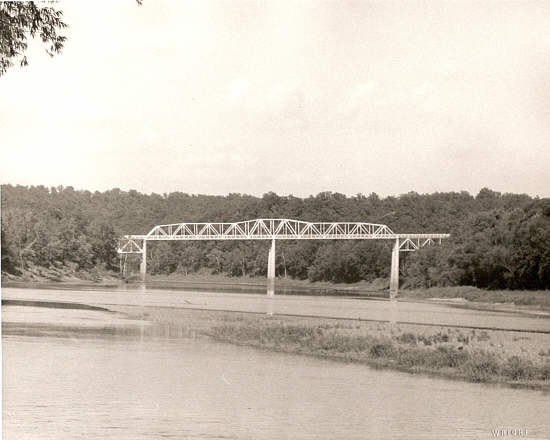 07 bridge from the river
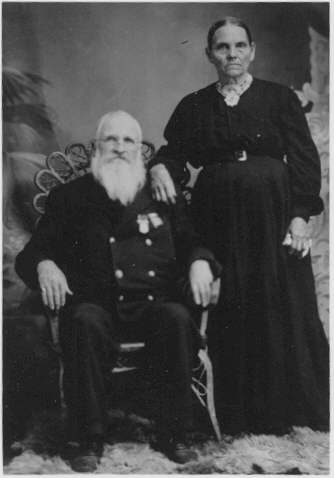 08 Squire John Ferguson and wife Dorcas
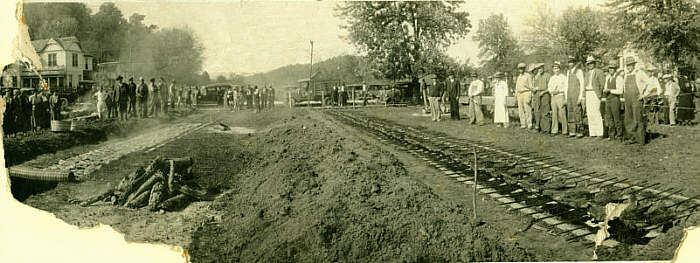 08a Celebration Barbcue
 09 New bridge and old bridge Another bridge in Tuscumbia is the much smaller Shut In Branch bridge. Judge Clyde Lee Jenkins, in his history of Miller County, describes from court records the building of the original bridge (photo 10):
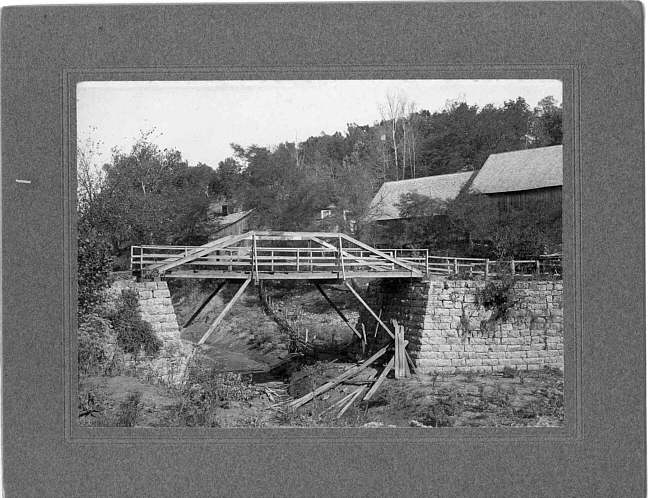 10 Old bridge across Shut In Branch
JUDGE JENKINS' HISTORY OF MILLER COUNTY
BRIDGE ACROSS SHUT-IN BRANCH
In the summer of 1852. one hundred sixty seven citizens
petitioned the Miller County Court to erect a bridge across
the Shut-In branch. In November the County Court appointed David P. Taylor, James Winfrey, Sr., and Robert E. Simpson, County Missioners, to meet in Tuscumbia on the "second Monday in December "and examine
the road leading from Tuscumbia up the river towards Erie,
and report as to the utility of said road, and the necessity
of erecting a bridge across the Shut-In branch, and the probable costs should a bridge be necessary.
On the third Monday in December the Commissioners in-
formed the Court a bridge should be built. On December 21, the Court ordered a "bridge erected across the Shut-In branch at Tuscumbia of solid rock ten feet high and 10 feet in width, and to extend on the North Side of said branch to the second bank, and as far on the South bank as said bridge running straight will strike said South bank of the branch. The bridge is to be arched over, leaving an opening for water to pass through not less than four feet, to be of strong and substantial stand with two good sills 10 inches square placed on top of the wall, with three or more pieces of cross timber 10 Inches square.
All of said timber to be of good sound white oak, the cross
pieces to be even with the top of the bridge, well fastened
to the sills with good and substantial railing on each side of the bridge. There is appropriated a sum of $150 for building the bridge, with Champ Smith appointed Commissioner to let out and oversee construction. The bridge is to be let out on the first Monday in February, and completed by the first Monday in August 1853."
Later, the Court amended this order by words "to leave
a space of 10 feet in the center of the bridge instead of four, and instead of being arched over, to be covered with good hewn timber 10 inches square, said timbers covered over with good rock or stone two feet deep." The building of the bridge was let to Daniel Cummings. On August 2, 1853. Cummings reported the bridge still incomplete. He requested more time to finish the work for "I cannot get men to work," said Daniel, "owing to the exceptionally hot weather, but I assure the Court I will finish It as soon as the weather gets a little cooler." The County Court, honoring his request, allowed him a warrant for one hundred dollars paid in part, for material and labor.
On November 14, 1853, Daniel Cummings reported the bridge finished, the County Court allowing him a warrant for fifty dollars pay, the remainder due him on his contract.
This was the first bridge across Shut-In branch situated
under the hill near the Big Spring in Tuscumbia.
The present Shut In Branch crossing is almost unnoticed as you start up Goosebottom street since it is a buried box style concrete tunnel over which the road passes (photo 11).
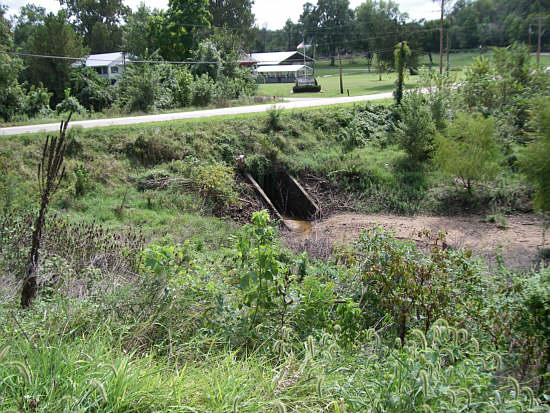 11 box tunnel Shut In Branch Another bridge across the Osage River near Tuscumbia was constructed in 1952 by Twentieth Century Fox, the Hollywood movie company, for the movie, "The Glory Brigade", released in 1953 starring Victor Mature and Lee Marvin. Interestingly to me, Victor played the role of Lieutenant Sam Pryor (some reviews of the movie spell it Prior, a common variation), who according to the movie, was of Greek descent. However, as an aside to this narrative, I have found through genealogical research of my own Pryor name that all the Pryors in this country came from France as French Huguenots, by way of England, where they lived for hundreds of years to escape the Protestant persecution then occurring in mainland Europe. Maybe the movie was implying that Lieutenant Pryor's mother was Greek.
At any rate, "The Glory Brigade" was filmed in my hometown of Tuscumbia, Missouri as well as nearby Fort Leonard Wood near Waynesville. Originally, it was to be named "Baptism by Fire" but the name was changed before release for reasons I never knew. I was about nine years old at the time and remember how exciting the event was for everyone in our small community of about 200 people situated on the banks of the Osage River in the picturesque Missouri Ozark hills. Victor Mature was loved by everyone because he was so friendly with the local natives, some of whom had cameras and who were delighted he would patiently pose and smile with his arm draped around one or another of us for one after another picture taking session between takes. In the next photo (photo 14) Victor is posing with Wanda and Mary Warren and Eula Jenkins. The Ozarks were chosen as the film site we were told because the terrain resembled that of much of Korea. My uncle Fred Pryor loaned Twentieth Century a John boat (local style of boat which was flat bottomed and narrow, designed for the clear, fast, sometimes shallow, spring fed Ozark streams) for use in construction of a pontoon bridge across the river, which was used in an important exciting scene in the movie. Unfortunately, one day while setting up some explosives for the scene in which the bridge was to be bombed, the dynamite accidently was discharged killing one man and causing another to lose his leg. No ambulances were around in those days and the nearest hospital was in Jefferson City, thirty miles away, so the men had little chance for emergency care. All of us were greatly saddened by the event as we had become friends with all the crew. I have seen "The Glory Brigade" several times on late night TV, even recently, and an amazed at how I can be drawn into the story of events supposedly taking place in Korea even though the scenes in the background are familiar to me, easily recognized as the hills around my home. The pontoon bridge built for the movie was photographed by my father, but, unfortunately, he didn't hold the camera motionless enough and it is somewhat blurred; but I'm going upload it anyway (photo 15). This bridge was constructed between the Lawson farm on the north side of the river and the Horton farm on the south side. Parts of the battle action were shot opposite the Glen Warren farm on the north side. Wanda Wright, daughter of Glen Warren and one of those pictured above in the photo with Victor, remembers well the battle scenes, the most memorable aspect of which was when the wounded or killed bloody soldiers suddenly sprung up alive at the end of each battle scene. Here listed is one of the many reviews of this movie you can find on the internet (click here).
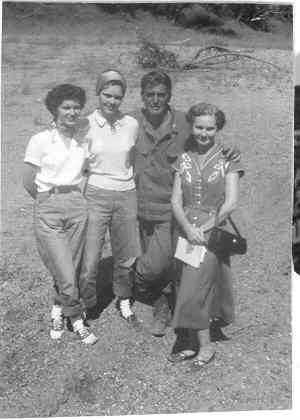 14 The Glory Brigade Wanda, Mary Warren, Victor, Eula Jenkins
 15 pontoon bridge for movie Glory Brigade Last week I and some friends (photo 16) traveled to O'Donnell, Texas for the purpose of helping Pat Childress (photo 17), owner of a ranch there, in his annual dove harvest, the results of which will be donated to the Wild Game Dinner to be held at Ninth Street Christian Church Saturday September 15. Don't miss this event because the entertainment is to be provided by the Martin Family (photo 18) of near High Point, Missouri who have become, in my opinion, one of the best Bluegrass musical groups around these days. I encourage you to take a look at their well designed web site (click here) to learn more about them and all the awards they have received this year and last.
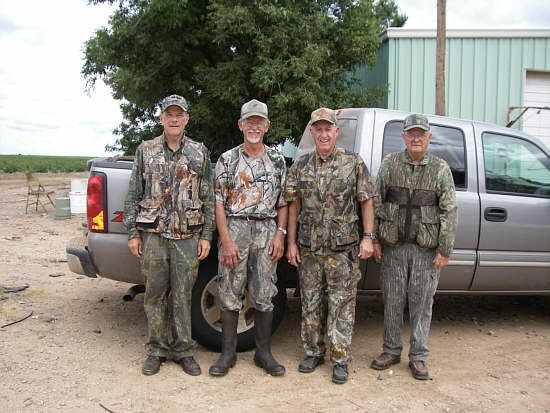 16 Joe Pryor,Ron Walker,Buster McGowin,Dr.Robert Mason
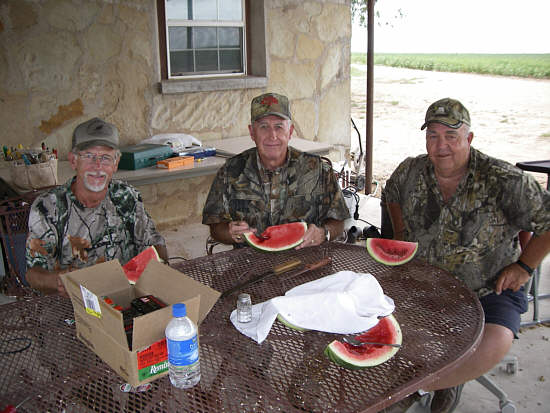 17 Ron Walker, Buster McGowin, Pat Childress
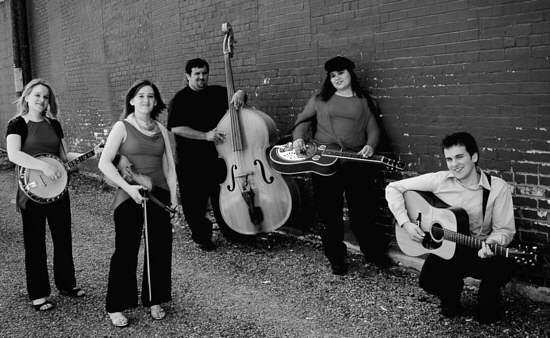 18 The Martins Our trip to O'Donnell included a tour of the town museum housed in the old bank (photo 19). I always try to visit museums in any new area I visit if I have time. Dan Blocker, Hoss Cartwright of the old Bonanza TV series (photo 20), was raised here and the town has dedicated much of the museum and a park nearby to him (photo 21 of bust). His family had a general store in O'Donnell (photo 22). Pat Childress told me that Dan as a young adolescent already was big and strong enough to hoist five filled feed sacks on his shoulders and arms to take them from the warehouse to the store. Pat is a descendent of the one of the original Childress's who signed the Texas State Charter, and the town of Childress, Texas is named after his family. While at the ranch we enjoyed home cooking of garden produce and wild game like I have never had before as prepared by Pat's wife, Melba Jo (photo 23). This area of Texas is mostly dedicated to raising cotton and sunflowers (photo 24), and more than a few rattlesnakes as well (photo 25).
 19 O'Donnell Museum
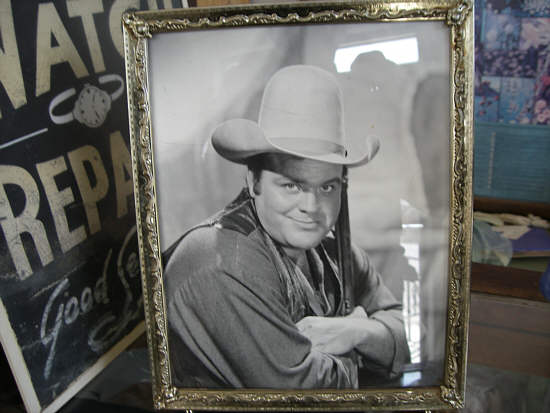 20 Dan Blocker
 21 Dan Blocker bust
 22 Blocker General Store
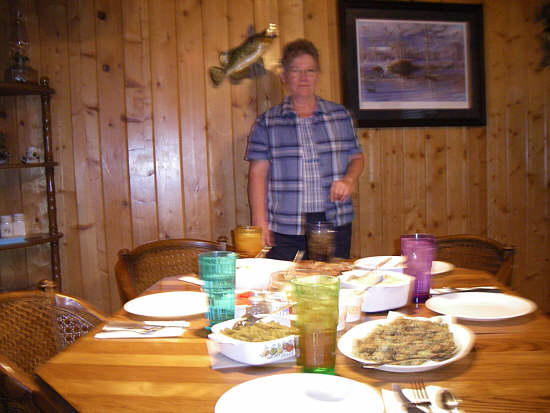 23 Melba Childress
 24 sunflower field
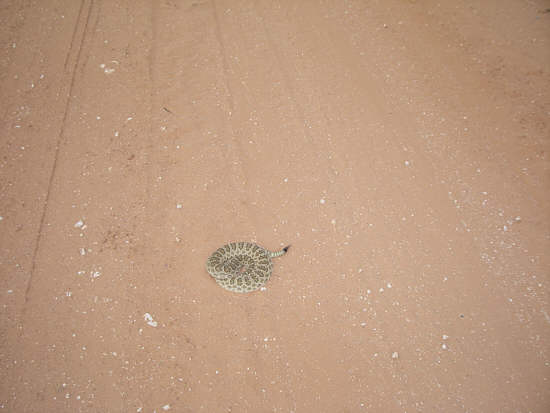 25 sand rattler Our Classic Car show Saturday enjoyed a fabulous response from visitors attending. We had the area in front of the museum filled with all types of cars from the fifties and before. An old Cord (photo 26) owned by Wes Scott of Brazito received a lot of attention. Several model A Fords were on site, all of which were very well restored. These included Eddie Miller's pickup of Eldon (photo 27), Bob Rush's pickup of Tuscumbia (photo 28), and Ernie Flaugher's sedan of Eldon (photo 29). Too many cars were present for me to have the space to show them all, unfortunately. The Hill Country band (photo 30) made up by Kenneth Cotton, Leo Barnhart, Joe Jeffries, Clifford Hill and Steve Mossman was on site to provide old time country music and we are very much indebted to these Miller County residents who volunteered their time to entertain us. I thank Clifford Hill and Joe Jeffries for organizing the band. I also want to thank Sharon Cogdill and Jack Lupardus for planning and managing the entire event which was a huge success for us.
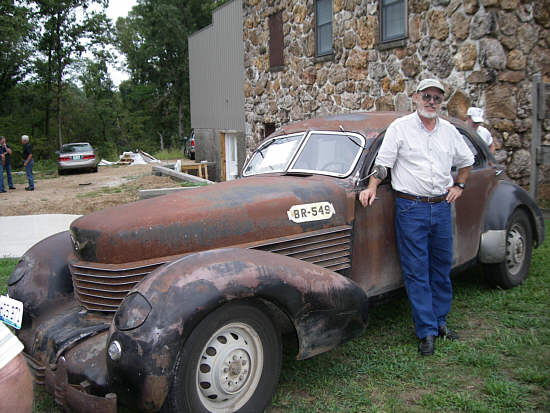 26 1937 Cord
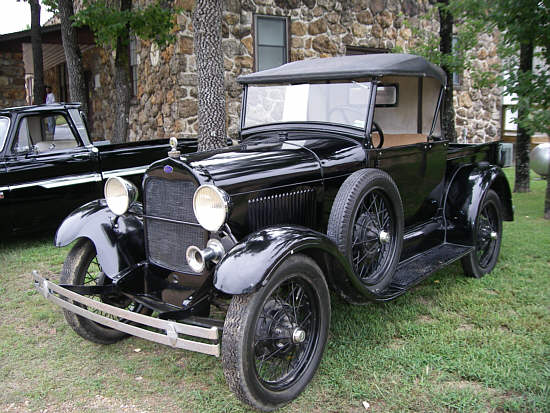 27 Model A Pickup
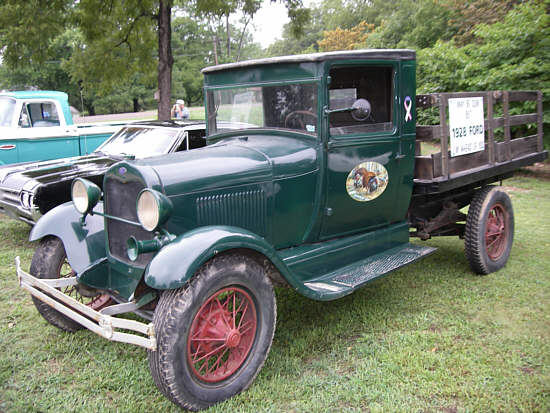 28 Model A Pickup
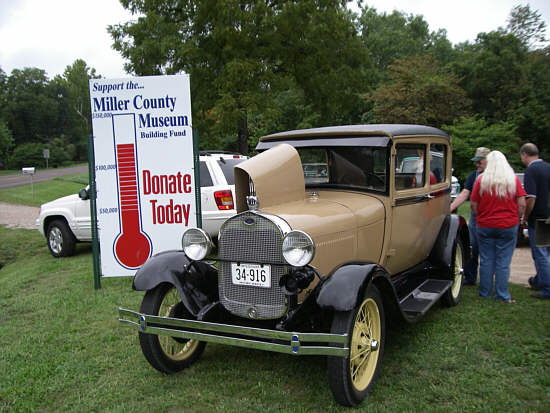 29 Model A sedan
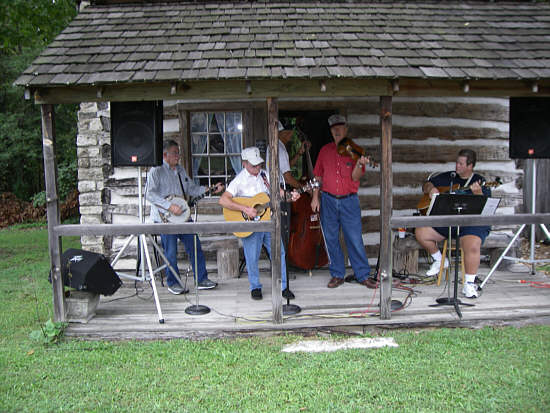 30 Hill Country Museum Band
This week Arthur and David Bear (photo 31) will continue their conversation about the medical care available to them in Miller County in the early part of the last century:
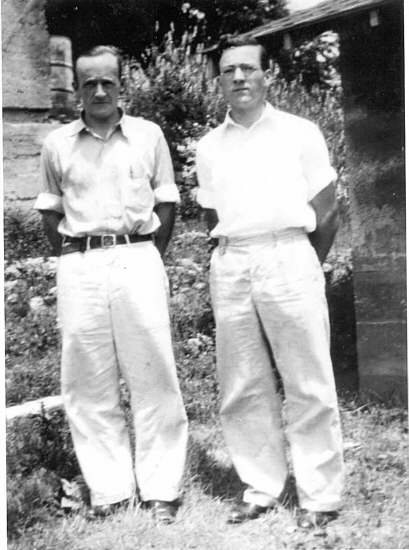 31 Arthur and David Bear David: Well, the country was full of characters through the
years, and we'll come back to that at another sitting. Let's
come back to the doctors for just a moment. I don't know what kind of training they had in those days, but certainly not
anything like we have today. I don't know how many courses
the med schools had for doctors in training, but from the kind
of medicine I saw practiced, it probably wasn't many. They
knew how to sew up wounds like a person would get at a Saturday night dance when the knives were wielded. Doc Kouns sewed up many of these, but not always in a sterile fashion. These doctors did have a good knowledge of symptoms, and could often tell you what disease you had, but there were no very effective medicines available for treatment. They were usually conscientious persons with an interest in people, but were limited by the state of the art of their profession. These doctors made house calls in town, and were always on call to go out to farm houses to minister. Babies were born at home usually with a doctor present. These early doctors made their rounds riding either on horseback or in a buggy. Doc Kouns bought a model T. Ford, probably in the early twenties. Catfish Williams drove it for him. Doc was a big man and probably was afraid to drive one of those horseless carriages. Often these doctors would stay up all night with a patient. Doctors of his time pulled teeth, performed minor surgery, and set broken bones. Much of their pay was in eggs, poultry, hams, etc. Much of it was on credit and often the doctor never got paid. Doc Kouns urged some of his farm customers not to eat ham for
health reasons but, instead pay their doctor bill with it.
In addition to Doc Kouns at Tuscumbia, I believe you mentioned Doc Dickson and Doc Nixdorf. Who else do you recall?
Arthur: Those were the only ones I knew, but each little town
had one or two doctors. Bagnell had one, Eugene had Dr. Glover, and, of course, Eldon had several, but I wasn't really acquainted with any more doctors.
David: You had an experience as a young man with a wound that you obtained in a car accident.
Arthur: Oh yeah, on the back of my hand.
David: Yeah, when your car tipped over. You and Frank Martin were in the car.
Arthur: Frank (photo 32 of Frank when member of Tuscumbia School Board) ran the car up on a bank and it tipped over. It was a model T roadster with no top on it for protection. We were on our way to play a baseball game, and Frank saw a girl that interested him, so he took his eyes off the road and ran up the slope of a bank and tipped the car over. I didn't get to play that day. It was on a Sunday afternoon so we got Doc Kouns to the office, and he immediately got out his needle and whatever he used for thread. He sewed me up. The needle was rusty, so he had to pull it through the skin with a pair of pliers. He used two-or-three stitches and treated it with ST 37, a mild antiseptic. He had me come back every morning for, oh, about a week, maybe a little longer and put ST 37 on it. One morning there were red streaks running up to my elbow. He put oh some more ST 37 and said," Ah, it looks good." I said, "Doc, I don't think it is, I want to see another doctor." He said, "O.K. I'll take you to Allee." Doc Allee was in Eldon, so we went up there with Catfish Williams driving. Doc Allee had a little better education than Doc Kouns. He took a glass probe and opened up the wound, (oooh! I shudder to think of
it yet) and poured it full of iodine. That was the kind of
remedy he had. I had the arm in a sling for five-to-six weeks
until it finally got well. That was a bad experience that I
had with Doc Kouns.
 32 Tuscumbia school board Doctor Humphreys, George Barron, Garrett Berry, Frank Martin, Ansel Pryor, Herman Abbett David: Well! These were conscientious people, but they didn't know much compared with today's doctors because the medical profession just hadn't developed very far. There were many diseases that they just couldn't deal with at all. Grandfather Bear had three children who died young. These boys would have been brothers of our Dad. One boy was named Edward and one was named Arthur. One died a young teenager, and the other from a childhood disease. Aunt Dora said it was from croup.
Arthur: I don't know what killed them.
David: Andrew, a third son, died at about the age of 21 years, and left a wife, Lulu, and a son, Evert, to survive him. The story I heard as a boy was that Andrew had been sickly even as a child, and that he probably died of some kind of a heart problem. Appendicitis was a disorder that was often fatal because surgery for it was not available. It was often diagnosed incorrectly as acute indigestion or colic. The major symptom was stomach pain which usually bothered the right side of the abdomen. The patient usually felt some relief when the appendix ruptured, but peritonitis then set in and death came fairly quickly. This was a common occurrence. At that time, facilities were not available for surgery on the appendix. Sometimes the symptoms of appendicitis got confused with acute indigestion. People died from abdominal pains, and often the lay diagnosis
was acute indigestion, but I suspect some of that was due to
coronary problems. The high fat diet of the people caused a
lot of indigestion and dyspepsia. The standard remedy was baking soda as an antacid. Abdominal pain can be caused by a number of things, and baking soda could not cure appendicitis, or coronary problems, so the earlier generations of people were really groping in darkness. Regardless of the medical problem, people got most of their treatment at home. Hemorrhoids (called piles) were treated at home without surgery. People just sat on their problems of this kind. Even the medicine used for this ailment was stuff like vaseline.
David: What I have just related in an unorganized fashion gives some idea of what life was like in the early days of Arthur and myself and the preceding generations. When we compare this with what we have today, there are scads of changes that we have lived through, and we are still living through tremendous changes. In 1922 we moved from the farm to town. This move did not bring about many changes, because farm folks and town folks lived about the same. The 1920's did usher in a new era of technology which was grabbing hold of our lives and also brought in some of the younger doctors whose training gave them some more modern ideas and methods. Arthur wants to say
a few words about these newer doctors who came on board during the 20's and 30's.
Arthur: Well, I was thinking about the young doctors, James
Allee, and Onley Shelton.
David: They started practicing in the early thirties?
Arthur: And they had some kind of hospital set up in a private home in Eldon. They performed a lot of surgery and treated many diseases in a much better way than had been done previously.
David: This was a step far in advance than what their fathers
could do?
Arthur: Yeah, and they had such funny names for some
diseases. There was leakage of the heart and lockage of the
bowels. If I had time to think, I could come up with some others. They probably didn't understand the problem, but they knew the symptoms and put a name to it. And the medicines they made up for us were formulated based on scientific studies which proved they had some type of beneficial effect too.
Next week Arthur and David will talk about the general store that their father, Madison Bear, owned in Bagnell during the building of the Bagnell Dam as well as the hard times of the depression era in general.
The "what's that thing used for" this week is pictured here (photo 33). Can you figure out what it was used for around the farm in days gone by?
 33 what is it It is a chicken catcher. Simply try to catch the chicken's hind leg with the hook and pull it in. This simple device was used for catching chickens running around the ground surrounding the barn or shed where the expanse of territory made it difficult to get one by hand. However, I remember the time when the method of raising broilers in a confined area reached Miller County in the late forties and early fifties. My dad ordered 2500 chickens and put them all together in an average sized shed we already had on the farm. Feeding troughs and water bottles placed upside down on a tray were bought as well. All the feeding and watering was done by hand daily, sometimes more often. Everyone thought that was the largest number of chickens in one place they had ever seen. But, of course, nowadays multiple thousands of chickens are placed in long low profile buildings which have automatic feeders and waterers. We were getting about thirty five cents a pound then and that was really good money. Then the bottom dropped out of the market since everyone was buying chickens to raise this way and when the price dropped to twelve cents a pound things got a lot tougher to make any money. I remember all of us boys catching chickens by hand; I could hold four chickens by one leg in each hand. We would deliver them to the fellow on the truck who put them in the cages. Now the chickens are driven to automatic runways and the loading is much simpler. One year in the early fifties soon after we started raising chickens the Osage flooded once again and since our chicken shed was in a low lying area the water got in and covered the floor with all the chicken litter (and you know what else) mixed in. Dad said it was my job to scoop it all out and take it away. Finally, he felt sorry for me and got Orb and Otto to come and help me. Orb and Otto will be the subject of an upcoming narrative. They were two of the many interesting characters around Tuscumbia when I was growing up.
Progress continues on the new museum building addition. This last week the painting was finished and the heating and cooling system was installed (photos 34 and 35). Hardwood flooring will be used for the upper floor (photo 36 upper floor awaiting new wood floor covering). The tile for the lower floor is being put in place by David Ruiz (photos 37 and 38). You will notice a lack of windows in the new addition. This was not an oversight but is a common feature of museum design since sunlight destroys old documents, photos, paintings and other valuable items. A benefit of no windows is our insulation will be improved saving heating and cooling bills. Expenses are always a consideration with volunteer managed and donation dependent organizations such as most museums are. We as yet, although having an excellent response on our fund raising effort, still are short of what the budget will require for finishing the addition. So if you would care to donate any amount, remember it is automatically doubled by an anonymous donor which really adds up, even with the smallest of gifts.
Our address for donations is:
Miller County Building Fund
P.O. Box 57
Tuscumbia, Mo. 65082
 34 duct vents downstairs
 35 furnace unit
 36 upstairs floor
 37 Ruiz Tile
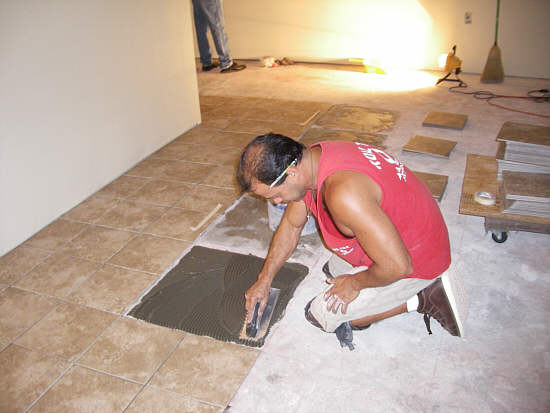 38 David Ruiz That's all for this week. Don't forget the Wild Game Dinner at Ninth Street Christian Church in Eldon Saturday September 15 where the fabulous Martin Family will be performing.
|



